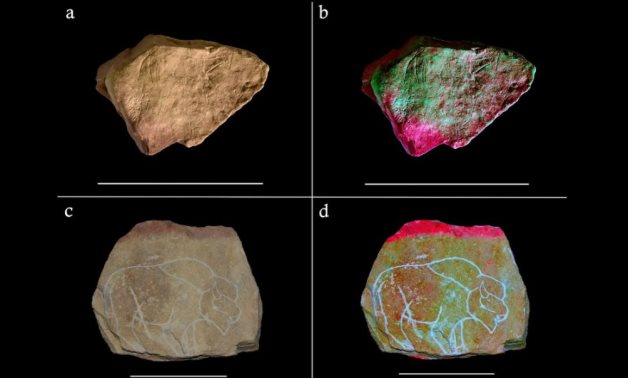
The researchers made replicas of 50 limestone plaquettes excavated from the Montastruc rock shelter in the 19th century - Image credit: Needham et al., 2022, PlOS One, CC-By 4.0
CAIRO – 26 April 2022: A recent British study confirmed that the oldest animation in the world did not appear in the late 19th century as widely believed, but rather thousands of years before that when images of ancient animals on flat stones were deliberately engraved so that they appear animated in the dim light of fire.
According to the study, creating such animated sculptures may have been a common prehistoric activity, especially when family groups gathered around a fire. The study suggests that some wall paintings and carvings found in ancient caves may have been influenced by their appearance in moving light and flame shadows.

The researchers made replicas of 50 limestone plaquettes excavated from the Montastruc rock shelter in the 19th century that are thought to have been created between 12,000 and 16,000 years ago. Image credit: Needham et al., 2022, PlOS One, CC-By 4.0

“When you get this dynamic light across the surface, suddenly all these animals start to move; they start to flicker in and out of focus,” archaeologist Andy Needham of Univeristy of York in the UK, who conducted the study, told Live Science.
Needham is the lead author of a study published in the journal PLOS ONE that describes how some images of animals carved on flat limestone rocks in a prehistoric cave in southern France were exposed to the effects of nightlife stoves.
The study indicates that the sculptures were primarily made to be "moved" by firelight. The researchers made films of their findings, with firelight dancing across a delicate 3D model of a carved panel decorated with engravings of wild horses.
“The interaction of engraved stone and roving firelight made engraved forms appear dynamic and alive, suggesting this may have been important in their use,” the researchers wrote in the new study. “Human neurology is particularly attuned to interpreting shifting light and shadow as movement and identifying visually familiar forms in such varying light conditions,” the study added.
Comments
Leave a Comment